Piper by Qualified Alternatives
Considering a switch from Piper? This article reviews 10 alternatives, comparing their core functionalities, pricing models, and ideal use cases.

You might use Piper by Qualified for very specific tasks, and for good reason. It performs well in certain areas, particularly with its AI for inbound sales development. For those jobs, it can be a solid choice.
However, no tool fits every need. Some users find limitations that prompt a search for alternatives. We've analyzed the best alternatives based on G2 reviews to help you shortlist your options for a deeper look. Let's get started.
Consider 11x for Your Sales Team
If your sales team is exploring digital workers, consider 11x. The platform provides autonomous agents designed to handle specific sales functions. You can book a demo to see how these agents perform and if they fit your operational needs.
At 11x, we provide a GTM platform that uses AI agents to manage the sales process. Our agent Alice finds prospects, runs outreach on email and LinkedIn, and updates your CRM. Julian qualifies inbound leads and books meetings. This approach unifies data enrichment, outreach, and email warmup tools into one platform.
Piper by Qualified Alternatives
Here is a detailed breakdown of top Piper alternatives. We will examine each tool's pricing, core features, and how they stack up against Piper in terms of strengths and weaknesses.
1) Outreach
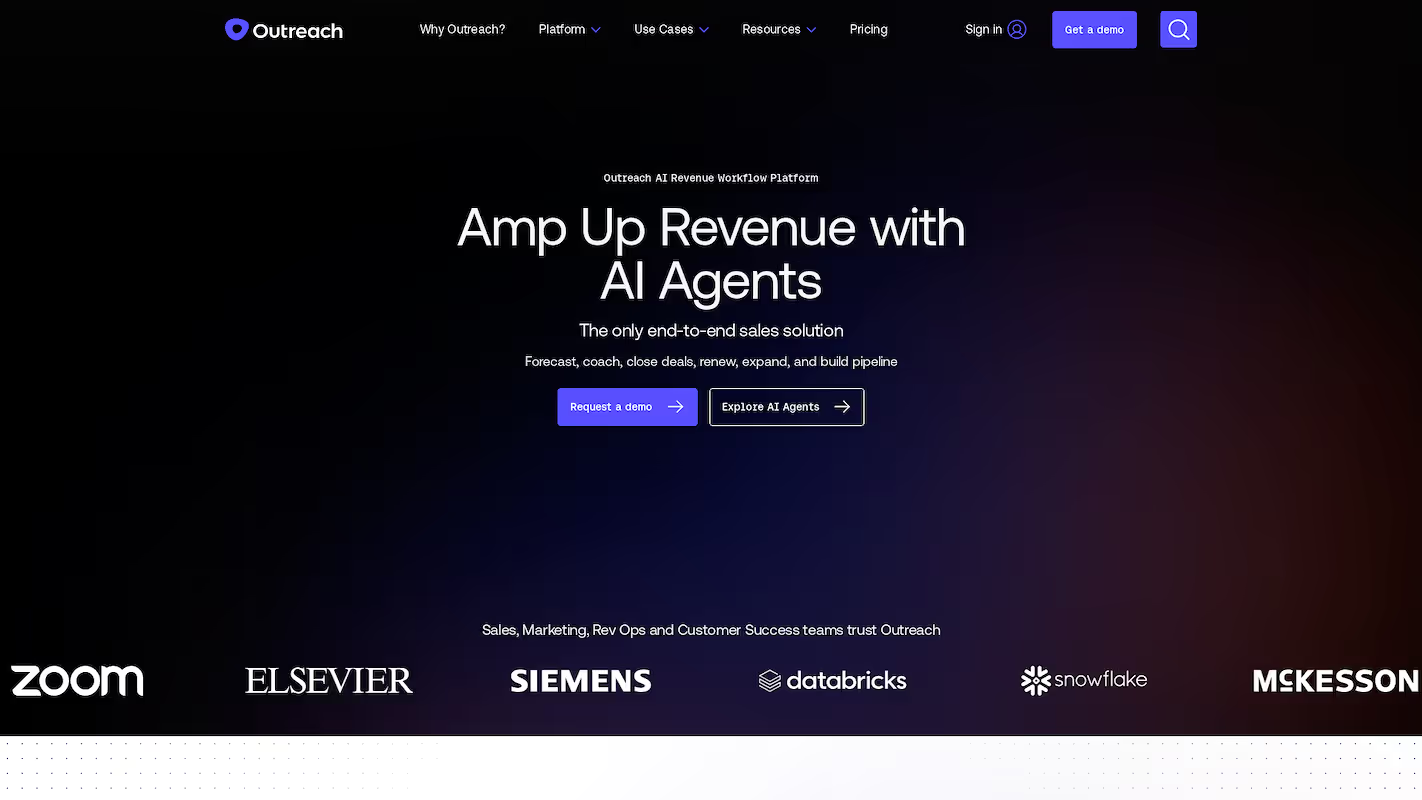
Outreach is a revenue workflow platform that uses AI agents for the sales cycle. It helps teams build pipeline, forecast revenue, and manage deals. The platform emphasizes security, privacy, and governance for sensitive customer data.
Use cases include the organization of business books and outbound communication to increase qualified pipeline. The system also supports the creation and execution of action plans with prospects and customers.
Outreach's Main Features
- Offers AI-driven coaching through Kaia, which provides meeting summaries, analytics, and deep-linked call moments for managers.
- Predicts revenue outcomes, identifies pipeline gaps, and runs scenario forecasts with its pipeline and forecast analytics.
- Detects buyer sentiment and topics across meetings, calls, and emails to provide insights into customer interactions.
- Delivers real-time content guidance during live meetings with prompts and enablement content cards via Kaia.
How Outreach Compares to Piper by Qualified
Average Review score: 4.3/5 stars based on 3,479 G2 reviews.
- Outreach provides a unified platform for sales engagement, revenue intelligence, and operations, which is different from Piper's specific focus on AI for inbound sales.
- The tool offers AI-driven coaching through its Kaia feature, which analyzes calls and provides feedback for sales teams.
- It includes advanced pipeline and forecast analytics to predict revenue, a capability that extends beyond Piper's primary function of inbound lead management.
- This platform also detects buyer sentiment across calls and emails, offering a broader view of customer interactions than a tool centered on website conversations.
Potential Drawbacks Compared to Piper
- Outreach provides a wide range of sales tools, but it does not have Piper's specific function to qualify inbound leads directly from live website conversations.
- Its AI assists with broad sales cycle tasks like call coaching and revenue forecasts. This differs from Piper's AI, which is trained specifically to engage and convert website visitors.
- Some users find the platform can feel complex due to its extensive features, unlike Piper's more streamlined interface designed for a single purpose.
Budget and Pricing Considerations
Outreach does not publicly list its pricing, but user reviews indicate it is a premium-priced tool. For the most accurate pricing information, we recommend visiting the Outreach website to request a quote.
2) Salesloft
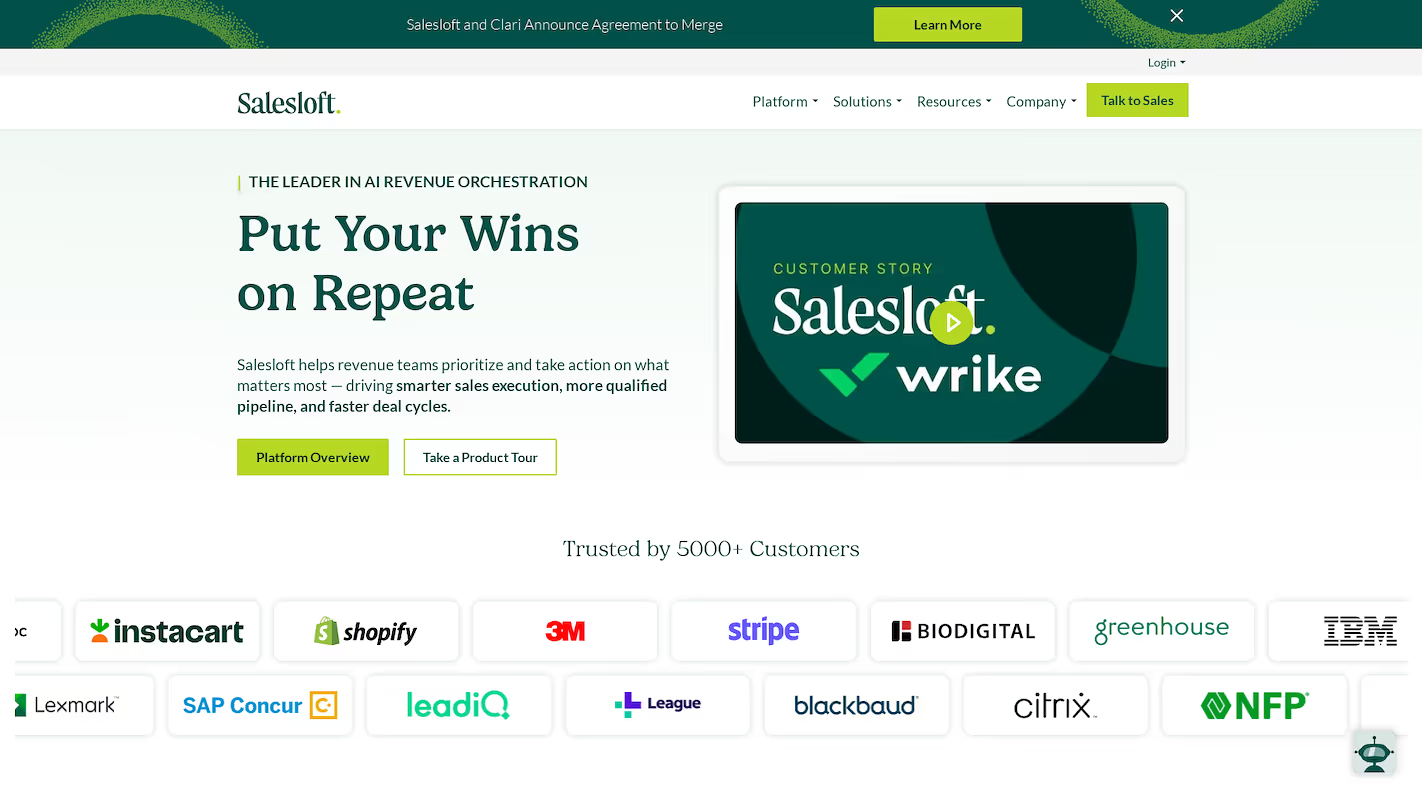
Salesloft is a Revenue Orchestration Platform that aligns sales engagement, AI insights, and forecasting in a single workflow. Its AI agents identify buyer signals, suggest next actions, and automate tasks to help teams build a qualified pipeline and shorten deal cycles.
Use cases include technology optimization, pipeline creation, and opportunity acceleration. The platform is designed to deliver measurable productivity and visibility for revenue teams.
Salesloft's Main Features
- Offers automated, structured workflows called Cadence to build pipeline, nurture leads, and handle renewals.
- Prioritizes actions with an AI engine named Rhythm, which recommends next steps at key moments.
- Analyzes recorded calls to generate buyer and seller insights for coaching and performance improvement.
- Creates sales forecasts by combining real-time deal data, AI, and seller input.
How Salesloft Compares to Piper by Qualified
Average Review score: 4.5/5 stars based on 4,145 G2 reviews.
- Salesloft provides structured workflows called Cadence to manage the entire sales cycle, a broader function compared to Piper's focus on inbound website leads.
- Its AI engine, Rhythm, prioritizes and suggests next actions for sales reps, which is different from Piper's AI that qualifies visitors in real time.
- The platform includes sales forecasting that combines deal data with AI, a revenue operations feature that Piper does not offer.
- It analyzes recorded calls to generate coaching insights for sales teams, whereas Piper's AI engages leads through live chat on a website.
Potential Drawbacks Compared to Piper
- Salesloft does not offer a dedicated AI for live website conversations. This differs from Piper, which qualifies visitors in real time directly on a company's website.
- The platform's AI assists with broad sales cycle tasks like prioritizing actions. This is less specialized than Piper's AI, which focuses exclusively on engaging and converting inbound website leads.
- The tool's wide range of features may create a more complex user experience for some teams. Piper, by comparison, offers a streamlined interface built for the single purpose of qualifying website visitors.
Budget and Pricing Considerations
Salesloft does not make its pricing public, but user data indicates it is a premium-priced tool. For the most accurate pricing information, we recommend visiting Salesloft's official website to request a quote.
3) Apollo.io
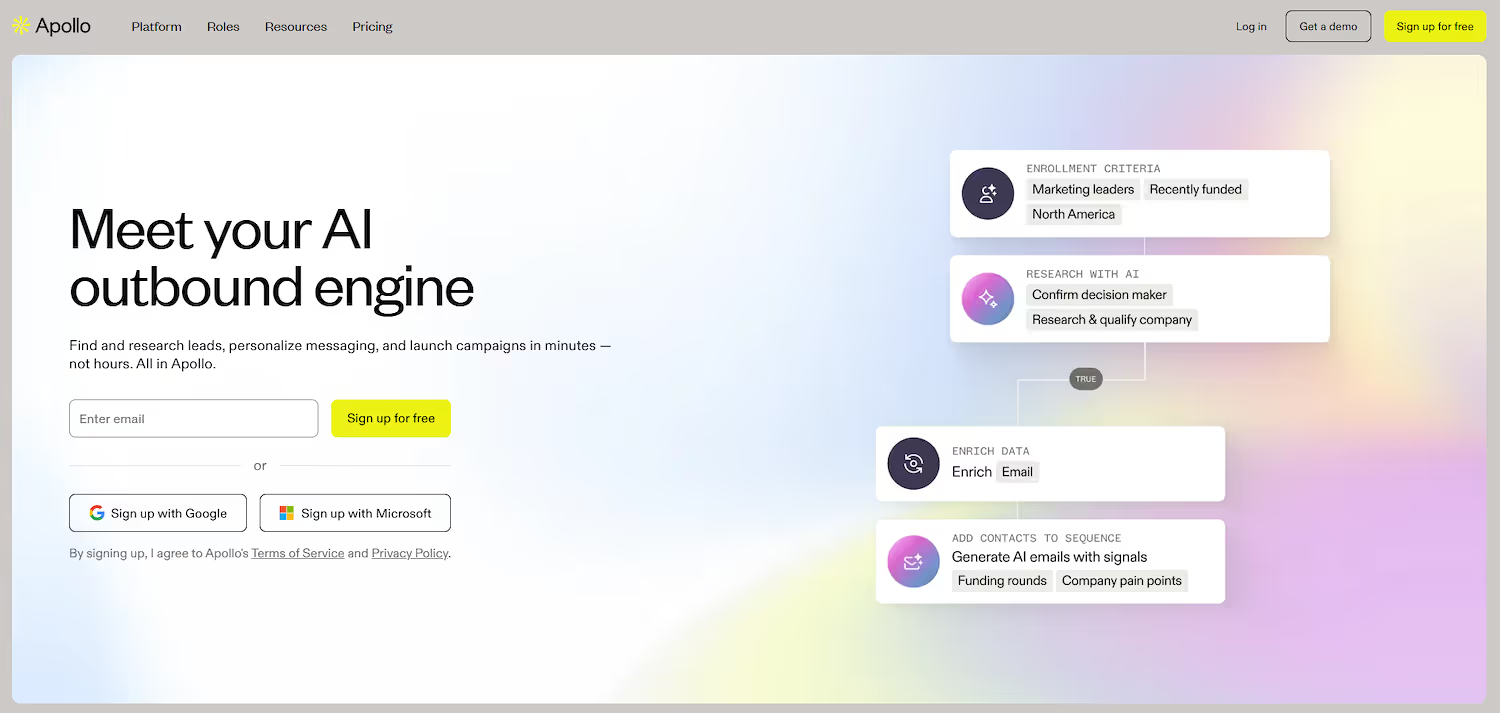
Apollo.io is a sales intelligence platform that offers contact data and engagement workflows. It helps sales teams find prospects, execute outreach, and manage their pipeline. The platform's tools support go-to-market strategies, from lead generation to the qualification of inbound interest.
Apollo.io's Main Features
- Provides a sales intelligence database with contact information for finding prospects.
- Features engagement workflows that allow teams to execute outreach.
- Includes tools for sales teams to manage their pipeline.
- Supports go-to-market strategies, from lead generation to the qualification of inbound interest.
How Apollo.io Compares to Piper by Qualified
Average Review score: 4.7/5 stars based on 8,904 G2 reviews.
- Apollo.io provides a database of over 210 million contacts for lead generation. This is a core difference from Piper, which engages visitors already on your website.
- The platform is an all-in-one tool for both outbound and inbound sales. In contrast, Piper has a specific focus on qualifying inbound leads from website chat.
- It includes engagement workflows to automate sales outreach across email and LinkedIn. Piper's AI does not manage outbound campaigns; it handles real-time inbound conversations.
- Apollo.io has a free plan available for individuals. This makes it more accessible than Piper, which does not publicly list a free option and targets enterprise clients.
Potential Drawbacks Compared to Piper
- Apollo.io does not offer a dedicated AI for live website conversations. This is different from Piper, which uses its AI to qualify visitors in real time directly on a company's website.
- The platform's AI assists with broad sales cycle tasks, such as finding prospects. This is less specialized than Piper's AI, which focuses exclusively on engaging and converting inbound website leads.
- Some teams might find the tool's wide range of features creates a more complex user experience. In comparison, Piper offers a streamlined interface built for the specific purpose of qualifying website visitors.
Budget and Pricing Considerations
Apollo.io offers transparent pricing with a free plan and paid tiers starting at $49 per user per month. In contrast, Piper does not publicly list its pricing and requires a custom quote, targeting enterprise clients.
This makes Apollo.io more accessible for teams needing predictable costs or a free entry point. You can review detailed pricing on Apollo.io's official website.
4) Groove

Groove is a sales engagement platform native to Salesforce that helps revenue teams with their sales process. It automates activity capture and provides workflow tools. Use cases include pipeline management, lead conversion, and support for account-based sales models.
Groove's Main Features
- Operates as a sales engagement platform built natively on Salesforce.
- Automates the capture of sales activities and logs them in the CRM.
- Provides workflow tools for pipeline management, lead conversion, and account-based sales.
How Groove Compares to Piper by Qualified
Average Review score: 4.6/5 stars based on 193 G2 reviews.
- Groove operates as a help desk platform with a shared inbox for customer support, which is different from Piper's focus on AI for live sales conversations.
- It includes a ticketing system to manage and track customer issues, whereas Piper qualifies sales leads in real time and does not handle support tickets.
- The tool provides a knowledge base for customer self-service, a support feature that Piper does not offer as its function is to engage website visitors for sales.
- This platform converts support emails into trackable cases within its workflow, while Piper's AI operates exclusively within a website's chat interface.
Potential Drawbacks Compared to Piper
- Groove does not provide a specialized AI to engage website visitors for sales purposes. This is different from Piper, which uses its AI specifically for real-time lead qualification on a website.
- The platform's features are built for customer support tasks, such as managing tickets from a shared inbox. It does not have Piper's function to convert website traffic into booked sales meetings.
- Some teams may find its workflow is not suited for sales development. Piper, in contrast, offers a streamlined interface designed for the single purpose of qualifying inbound leads.
Budget and Pricing Considerations
Groove offers transparent pricing with plans starting at $15 per user per month. This contrasts with Piper, which does not publicly list its pricing and requires a custom quote, a model often used for enterprise software.
5) HubSpot Sales Hub
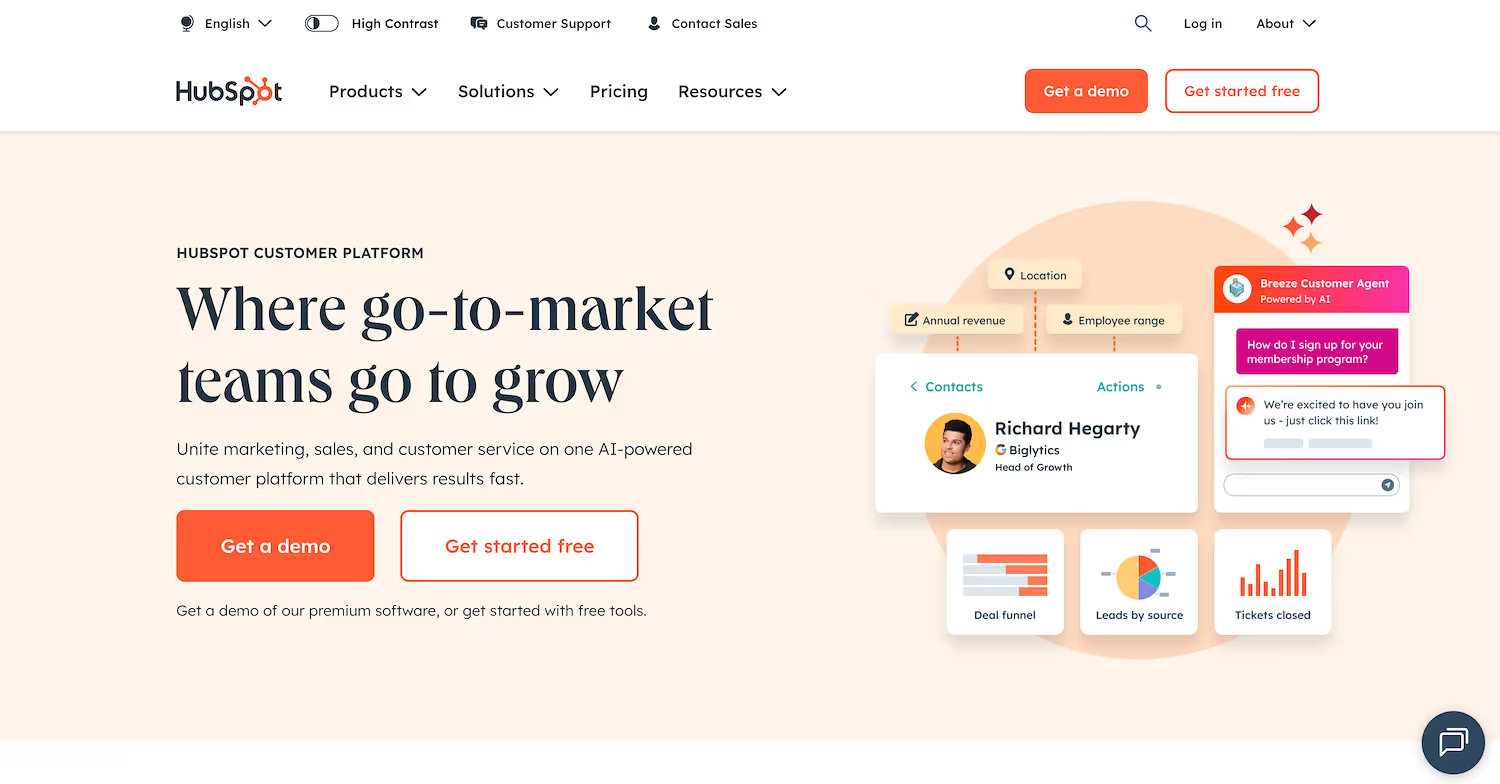
HubSpot Sales Hub is a sales software platform that helps teams close deals and manage their pipeline. It provides tools for sales engagement, performance analytics, and process automation to connect with prospects and accelerate the sales cycle.
Use cases include the automation of sales tasks and the management of the entire sales pipeline from a single platform.
HubSpot Sales Hub's Main Features
- Offers tools for deal and pipeline management, including quote creation, e-signatures, and payment processing.
- Uses AI for sales forecasting and predictive lead scoring to help prioritize efforts.
- Provides sales enablement materials like playbooks, scripts, and battlecards within the platform.
- Integrates with over 1,800 applications and works with other HubSpot hubs for marketing, service, and operations.
How HubSpot Sales Hub Compares to Piper
Average Review score: 4.4/5 stars based on 12,407 G2 reviews.
- HubSpot Sales Hub provides a full CRM platform that connects sales, marketing, and service data. This is different from Piper, which is a specialized tool for inbound website lead qualification.
- The platform includes tools for complete deal and pipeline management, such as quote creation and e-signatures. This covers the entire sales cycle, whereas Piper focuses on the initial lead capture stage.
- It offers sales enablement resources like playbooks and scripts directly within the system. This provides support for reps throughout the sales process, unlike Piper's focus on the first touchpoint.
- HubSpot's AI provides sales forecasting and predictive lead scoring to help prioritize deals. This is a different use of AI compared to Piper, which uses AI to engage website visitors in real time.
Potential Drawbacks Compared to Piper
- HubSpot Sales Hub does not include a dedicated AI for live website conversations. This is different from Piper, which uses its AI to qualify visitors in real time directly on a company’s website.
- The platform’s features are built for the entire sales cycle, which some teams may find complex. Piper, by comparison, offers a streamlined interface designed for the single purpose of qualifying website visitors.
- Its AI assists with broad sales tasks but is not trained for conversational sales. Piper’s AI specializes in engaging website visitors through natural dialogue to convert them into qualified leads.
Budget and Pricing Considerations
HubSpot Sales Hub offers transparent pricing with a free CRM and paid plans starting at $20 per user per month. This contrasts with Piper’s custom quote model, making HubSpot more accessible for teams that need predictable costs or a free entry point. You can review detailed pricing on the HubSpot website.
A Final Recommendation: 11x
After reviewing the alternatives, you might find that a platform with dedicated digital workers is a better fit. 11x provides autonomous agents that handle specific sales functions, from prospecting to lead qualification, unifying several parts of your sales process.
If your team wants to integrate digital workers into its sales operations, consider 11x. You can book a demo to see how its agents perform and determine if they meet your specific requirements. This provides a direct look at the platform's capabilities.
At 11x, we use AI agents to manage your sales process. Alice finds prospects and runs outreach, while Julian qualifies inbound leads and books meetings. Our platform unifies data enrichment, outreach, and email warmup tools, removing the need for separate solutions.
Book a demo to see 11x in action.
6) Revenue.io

Revenue.io is a RevOps platform that uses AI to guide sales teams. It provides real-time suggestions during calls and analyzes conversations for insights. The platform automates workflows and integrates with Salesforce to give a unified view of customer interactions.
Use cases include call coaching, sales forecasts, and pipeline management. The system helps teams identify at-risk deals and understand the actions of top performers. It is for sales teams that rely on phone calls and virtual meetings.
Revenue.io's Main Features
- It includes a Salesforce-native power dialer that connects reps to prospects and automatically logs activities.
- The platform uses generative AI agents to guide reps during calls, draft follow-up emails, and automate tasks.
- It delivers on-screen prompts during calls to help reps with objections and compliance.
- The system provides conversation intelligence with automatic call recording, transcription, and AI scorecards for coaching.
How Revenue.io Compares to Piper
Average Review score: 4.7/5 stars based on 549 G2 reviews.
- Revenue.io offers real-time guidance to sales reps during live calls. This is different from Piper, which qualifies leads through website chat conversations.
- The platform provides conversation intelligence by analyzing recorded calls for coaching insights. Piper's AI, in contrast, focuses on real-time website engagement and does not analyze past conversations.
- It includes a Salesforce-native power dialer to automate outbound calls. This function supports outbound sales, an area Piper does not cover as it focuses on inbound website visitors.
- This tool uses AI to draft follow-up emails based on call conversations. This is a different use of AI compared to Piper, which uses its AI to qualify leads and book meetings directly from a website chat.
Potential Drawbacks Compared to Piper
- Revenue.io does not offer a tool for real-time website conversations. This is a significant difference from Piper, which uses a dedicated AI to engage and qualify visitors directly on a company's website.
- The platform's features center on coaching for phone sales. It does not have Piper's specific function to convert anonymous website traffic into qualified sales opportunities.
- Its AI assists sales reps during calls, which is a different focus from Piper's AI. Piper's AI specializes in conversational sales to turn website chats into booked meetings without human help.
Budget and Pricing Considerations
Revenue.io does not publicly list its pricing, a model similar to Piper that requires a custom quote. User reviews suggest it is a premium-priced tool. For the most accurate pricing, we recommend visiting the Revenue.io website to request a quote.
7) Klenty
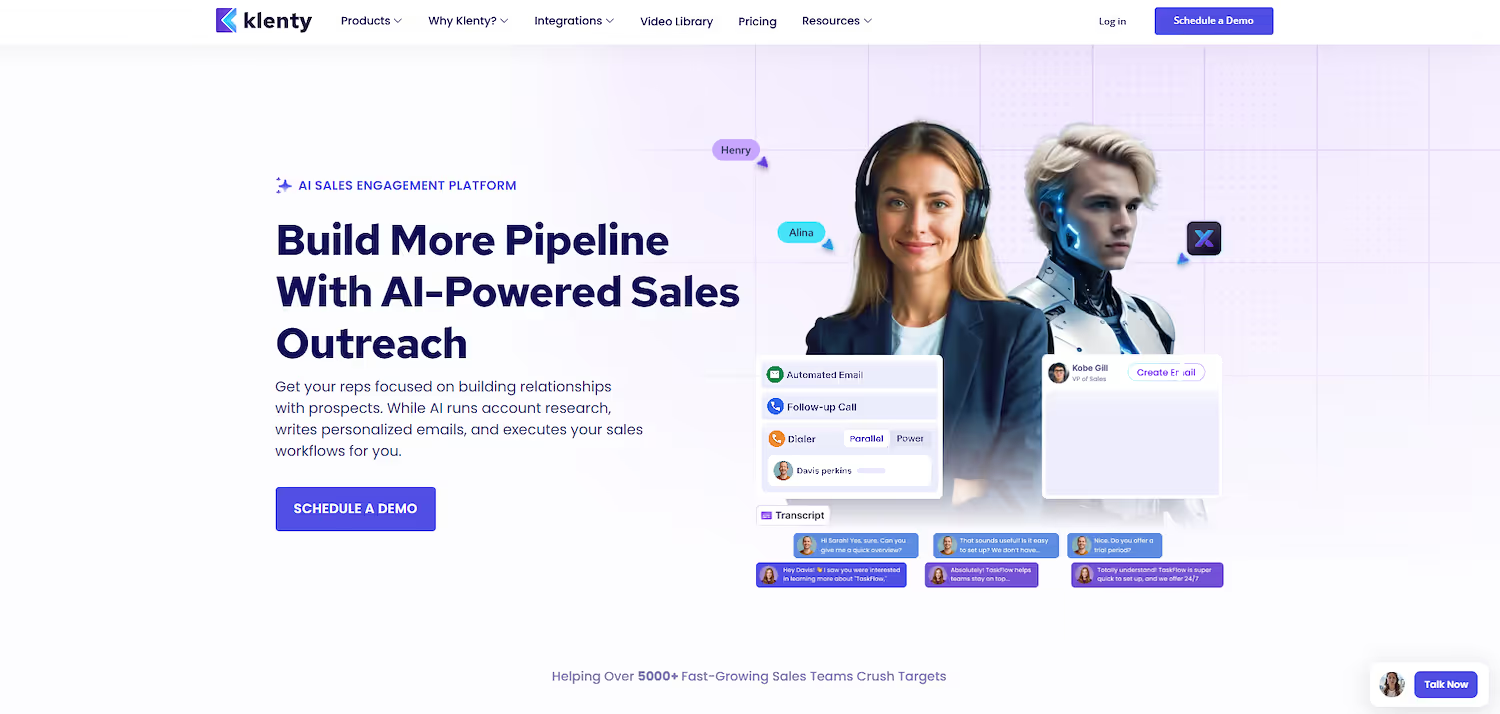
Klenty is a sales engagement platform that helps teams execute outreach and manage prospect interactions. Use cases involve the automation of sales sequences and follow-up with leads across multiple channels. The platform provides a framework for sales teams to structure their communication with potential customers.
Klenty's Main Features
- It orchestrates outreach across email, calls, SMS, WhatsApp, and LinkedIn from a single cadence builder.
- The platform includes a sales dialer with parallel dialing for up to five numbers at once and a power dialer for sequential list dialing.
- It offers an autonomous AI agent, SDRx, that researches accounts, creates outreach, and books meetings for outbound prospecting.
- An AI writer researches accounts and drafts personalized emails designed to land in the primary inbox.
How Klenty Compares to Piper
Average Review score: 4.6/5 stars based on 387 G2 reviews.
- Klenty orchestrates outreach across multiple channels, including email, calls, and LinkedIn. This differs from Piper, which focuses on real-time website conversations.
- It offers an autonomous AI agent for outbound prospecting that finds accounts and books meetings. Piper's AI, in contrast, handles inbound leads from website chat.
- The platform includes a sales dialer with a parallel dialing function. This feature supports outbound call campaigns, an area Piper does not cover.
- This tool provides deep CRM integrations to automate workflows for both inbound and outbound sales. This is a broader scope than Piper's specific function for website lead qualification.
Potential Drawbacks Compared to Piper
- Klenty does not offer a dedicated AI for real-time website conversations. This is a significant difference from Piper, which uses its AI to qualify visitors directly on a company's website.
- The platform's AI agent, SDRx, handles outbound tasks like account research and outreach. This is a different focus from Piper's AI, which is built for conversational sales with inbound website visitors.
- Its features are built for multi-channel sales cadences. Some teams might find this is less direct for inbound lead conversion than Piper's streamlined interface, which has a single purpose.
Budget and Pricing Considerations
Klenty offers transparent pricing with plans starting at $50 per user per month. This contrasts with Piper’s custom quote model, making Klenty more accessible for teams that need predictable costs. You can review detailed pricing on Klenty's official website.
8) Mixmax
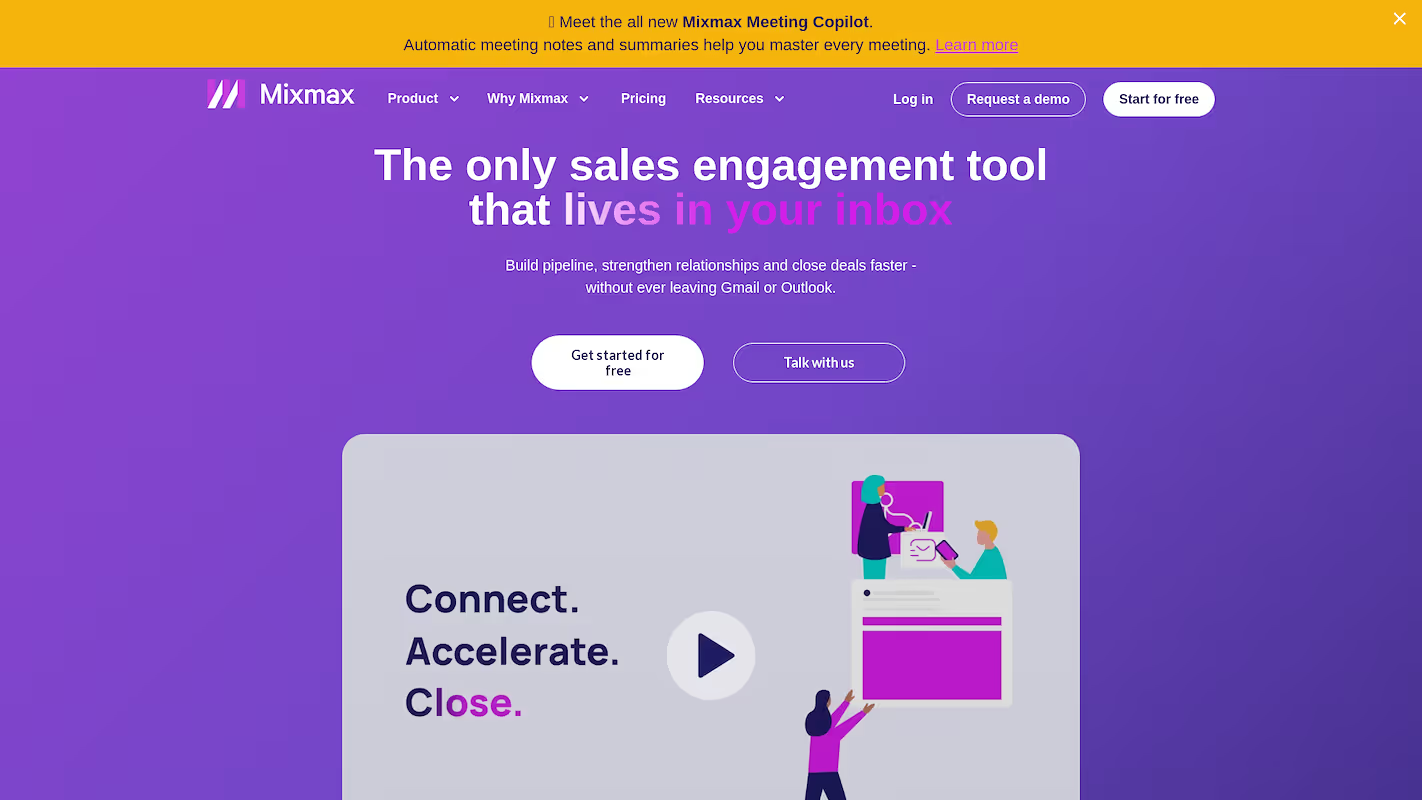
Mixmax is a sales engagement platform for teams that use Gmail. It enhances email with tools for prospect and customer communication. Use cases span the sales cycle, from outbound work to account management. The platform allows teams to manage all interactions from their inbox, which supports both sales and customer success functions.
Mixmax's Main Features
- Operates within the Gmail inbox, allowing users to manage workflows without switching applications.
- Includes email tracking for open rates, link clicks, and attachment activity, along with email scheduling.
- Allows for the embedding of polls and surveys directly within emails to increase recipient engagement.
- Automates repetitive tasks, such as Salesforce updates, and provides integrated workflow management.
How Mixmax Compares to Piper by Qualified
Average Review score: 4.6/5 stars based on 1,433 G2 reviews.
- Mixmax operates directly within the Gmail inbox, which allows teams to manage workflows without leaving their email. This is different from Piper, which functions as a separate AI chat tool on a company's website.
- It allows users to embed polls and surveys directly into emails to increase engagement. Piper, in contrast, engages leads through real-time chat and does not offer interactive email elements.
- The platform provides email tracking for open rates and link clicks. This gives insight into prospect engagement after an email is sent, a different function from Piper's real-time conversational analysis.
- This tool automates tasks like Salesforce updates from the inbox. This is a different approach to automation than Piper, which focuses on booking meetings directly from a website chat.
Potential Drawbacks Compared to Piper
- Mixmax does not have a function to engage anonymous website visitors. This is a notable difference from Piper, whose AI is built specifically to start conversations with site traffic and convert it into qualified sales opportunities.
- The platform's AI focuses on email productivity and workflow automation within Gmail. This is a different application of AI compared to Piper, which uses its AI for conversational sales to book meetings without human intervention.
- Some teams may find that an email-centric tool is less direct for inbound lead conversion. Piper offers a more streamlined interface for this single purpose, as it is designed to qualify website visitors through chat.
Budget and Pricing Considerations
Mixmax offers transparent pricing with plans starting at $49 per user per month. This contrasts with Piper’s custom quote model, making Mixmax more accessible for teams that need predictable costs. You can review detailed pricing on the Mixmax website.
9) Mailshake
Mailshake is a sales engagement tool for cold email outreach. It helps sales teams send personalized emails at scale and automate follow-up sequences. The platform focuses on connecting with prospects through email to generate leads and book meetings.
Use cases include outbound sales efforts and lead generation. Teams use it to automate email campaigns, manage responses, and track engagement. It is for sales professionals who need to build a pipeline through cold outreach.
Mailshake's Main Features
- Automates cold email campaigns with personalized sequences and follow-ups.
- Includes a built-in phone dialer to call prospects directly from the platform.
- Provides a "Lead Catcher" feature to manage and prioritize interested leads from replies.
- Offers A/B tests for email copy to help improve campaign performance.
How Mailshake Compares to Piper
Average Review score: 4.7/5 stars based on 403 G2 reviews.
- Mailshake is a tool for cold email outreach to generate new leads. This is different from Piper, which engages visitors already on your website through live chat.
- The platform automates outbound email sequences and follow-ups. Piper's AI, in contrast, automates inbound conversations to qualify leads in real time.
- It includes a phone dialer for direct calls, a feature for outbound sales. Piper does not have outbound call capabilities as it focuses on website interactions.
- This tool helps manage replies and identify interested prospects from email campaigns. Piper's function is to qualify leads and book meetings directly from a website chat interface.
Potential Drawbacks Compared to Piper
- Mailshake does not offer a tool for real-time website conversations. This is a significant difference from Piper, which uses a dedicated AI to engage and qualify visitors on a company's website.
- The platform's features are built for outbound email campaigns. It does not have Piper's specific function to convert anonymous website traffic into qualified sales opportunities through chat.
- Some teams may find that an email outreach tool is not suited for immediate inbound lead qualification. Piper offers a streamlined interface designed for this single purpose.
Budget and Pricing Considerations
Mailshake offers transparent pricing with plans starting at $58 per user per month. This contrasts with Piper’s custom quote model, making Mailshake an option for teams that need predictable costs. You can review detailed pricing on the Mailshake website.
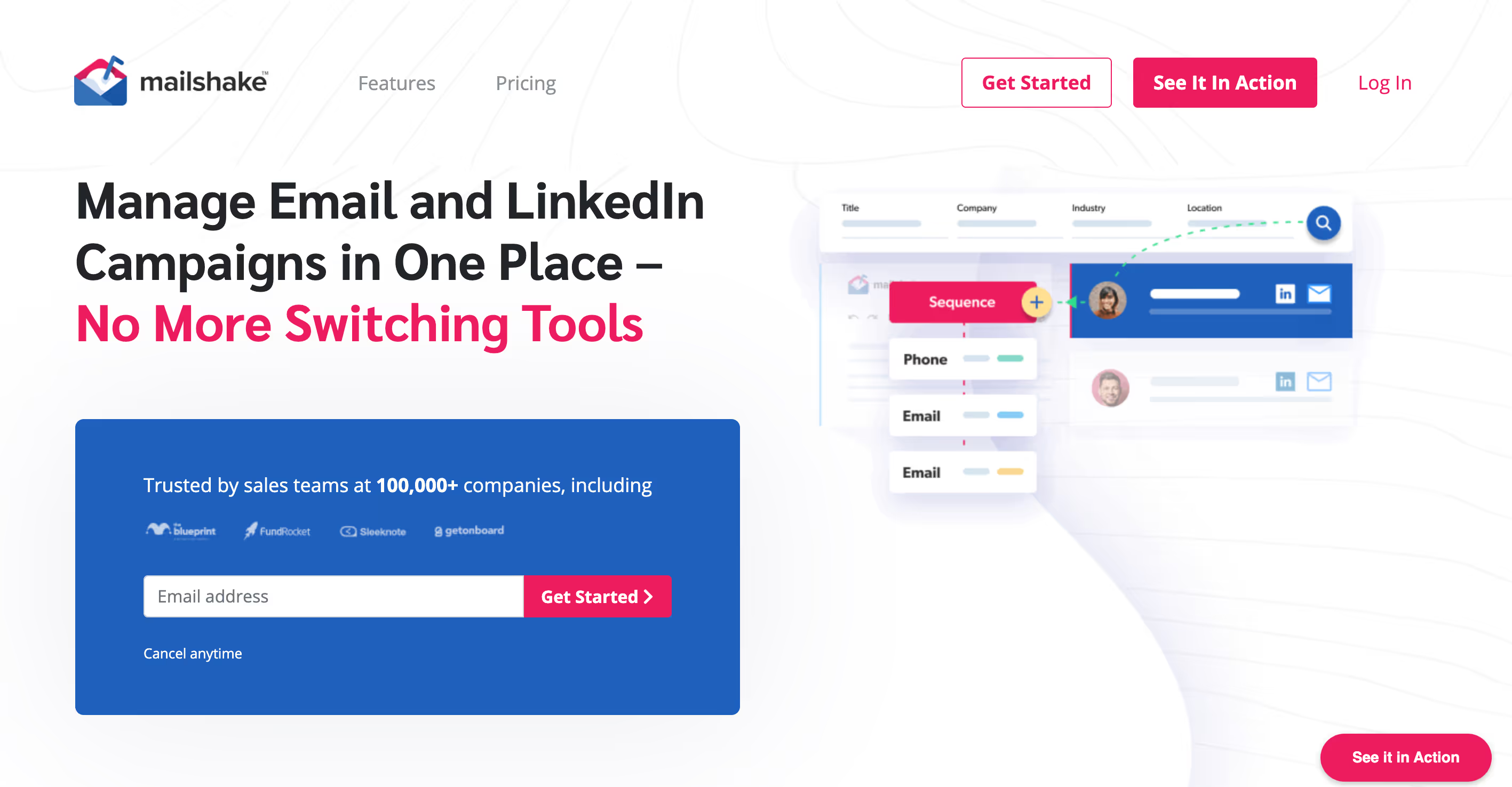
Mailshake is a sales engagement tool for cold email outreach. It allows sales teams to send personalized emails at scale and automate follow-up sequences. The platform helps connect with prospects through email to generate leads and book meetings.
Use cases include outbound sales and lead generation. Teams use it to automate email campaigns, manage responses, and track engagement.
Mailshake's Main Features
- Automates personalized cold email sequences and follow-ups at scale.
- Sets tasks to engage with prospects via phone and social media in one sequence.
- Uses lead scoring and prioritization to identify the most engaged prospects.
- Schedules emails based on the best time of day to improve engagement.
How Mailshake Compares to Piper by Qualified
Average Review score: 4.7/5 stars based on 326 G2 reviews.
- Mailshake automates cold email outreach to find new leads, which is a different approach from Piper's focus on interacting with visitors already on your website.
- It allows you to set tasks for phone and social media contact within a single sequence, while Piper's interactions are limited to website chat.
- The tool uses lead scoring to prioritize prospects from outreach campaigns. In comparison, Piper qualifies leads in real time during a website chat session.
- This platform can schedule emails to send at an optimal time for better engagement. Piper's conversations are immediate and depend on when a visitor is on the site.
Potential Drawbacks Compared to Piper
- Mailshake does not provide instant engagement on a website. Its email-based system introduces a time lag, whereas Piper starts a conversation the moment a visitor arrives.
- The platform is designed for cold outreach, not for handling warm, inbound traffic. It cannot identify a high-intent visitor on the website and start a tailored sales conversation, which is a core function of Piper.
- Its AI functions as an assistant for tasks like email writing. This is a different approach from Piper, where the AI acts as an autonomous agent that handles the entire conversational sales process on the website.
Budget and Pricing Considerations
Mailshake offers transparent pricing with plans starting at $29 per user per month. In contrast, Piper requires a custom quote and does not publicly list its prices. This makes Mailshake more accessible for teams that need predictable costs, while Piper's model is common for enterprise software.
10) Reply.io
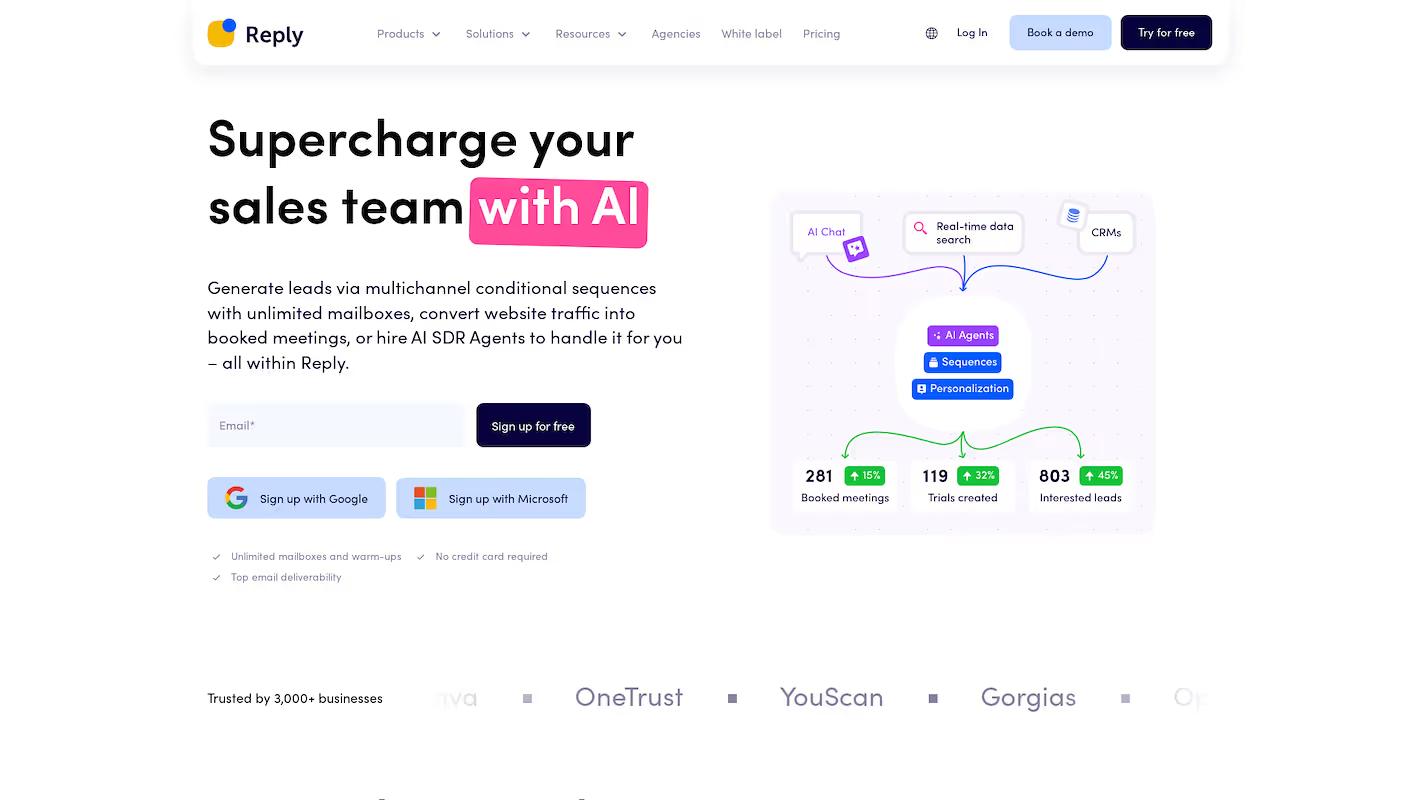
Reply.io is a sales engagement platform that uses AI to automate multi-channel outreach. It helps sales teams connect with prospects through email, social media, and calls to book meetings.
Use cases include outbound prospect development and inbound lead response.
Reply.io's Main Features
- Automates sales outreach across multiple channels, including email, LinkedIn, WhatsApp, SMS, and calls.
- Uses AI SDR agents to find prospects, automate outreach, and handle responses to book meetings.
- Provides an email deliverability suite with SPF, DKIM, and DMARC monitoring and email warm-ups.
- Offers an agency growth hub with an API, a dedicated dashboard, and bulk mailbox imports for client management.
How Reply.io Compares to Piper by Qualified
Average Review score: 4.6/5 stars based on 1,458 G2 reviews.
- Reply.io automates outreach across multiple channels, including email, LinkedIn, and WhatsApp. This is a broader approach compared to Piper, which focuses only on website chat.
- It provides AI SDR agents that find prospects and automate outbound outreach. This is different from Piper's AI, which handles inbound leads already on the website.
- The tool offers an AI chat for websites that includes video avatars. This adds a visual element to the chat experience, a different approach from Piper's text-based AI chat.
- This platform includes an email deliverability suite with tools for email warm-ups and technical monitoring. This feature supports email outreach, an area Piper does not cover.
Potential Drawbacks Compared to Piper
- Reply.io provides an AI chat as one part of a larger platform. This is different from Piper, which is a specialized tool with an AI trained only for conversational sales on a website.
- The platform's primary AI agents handle outbound tasks like finding new prospects. This contrasts with Piper's AI, which focuses entirely on managing inbound conversations with website visitors.
- Its broad, multi-channel features may be complex for a team that only needs to convert website traffic. Piper offers a streamlined tool built specifically for that purpose.
- The tool's AI chat includes video avatars, which adds a visual component. Some users might prefer Piper's text-only AI, as it can provide a more direct chat experience.
Budget and Pricing Considerations
Reply.io offers transparent pricing with a free plan and paid tiers starting at $49 per user per month. This contrasts with Piper’s custom quote model, making Reply.io more accessible for teams that need predictable costs or a free entry point. You can review detailed pricing on the Reply.io website.
Which One Should You Go With?
Choosing a Piper alternative depends on many variables, including your team's specific needs and existing workflows. This guide has presented several options to help you make an informed decision for your sales operations.
If you are looking for a platform with autonomous agents, consider 11x. It provides digital workers for specific sales functions, from prospecting to lead qualification, unifying multiple tools into a single platform. You can book a demo to see how it works.




